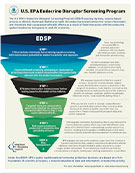July 02, 2015
EPA releases EDSP Tier 1 screening results
After years of delay, the US EPA has released the first results for its endocrine disruptor screening programme (EDSP).
The results are for tier 1 screening assays for the first 52 chemicals in the programme. Tier 1 screening is used to determine if a chemical has the potential to interact with the the endocrine system and requires more testing under tier 2.
The screening tests showed that for 20 of the 52 chemicals, there was no evidence of potential interaction with any of the endocrine pathways. Fourteen showed potential to interact with one or more pathways, but the agency has “enough evidence to conclude that they do not pose risks”.
All the remaining 18 chemicals showed potential interaction with the thyroid pathway, 17 of them with the androgen pathway and 14 also potentially interacted with the oestrogen pathway.
The EPA made clear that a tier 1 test result, indicating potential to interact with the endocrine system, “should not be construed as meaning that EPA has concluded that the chemical is an endocrine disruptor”.
The agency plans to do tier 2 testing for chemicals that have shown potential to interact with the endocrine system. It is recommending a comparative thyroid assay for four chemicals that showed interaction with the thyroid pathway in mammals, a medaka one-generation reproductive test for 13 that showed interaction with the oestrogen or androgen pathways in wildlife, and a larval amphibian growth and development assay for five chemicals that showed interaction with the thyroid pathway in wildlife. This, it said, would help it “better understand the potential of these chemicals to cause adverse effects through interaction with the endocrine system”.
The EPA also noted that endocrine disruptor screening is just one category of testing it does on chemicals to determine their health and environmental impacts. Substances that did not require further testing in the first EDSP screening could still require other testing as part of the risk assessment done by the EPA.
For tier 2 testing, the agency will allow four years for data generation and one year for its review (CW 24 February 2014).
The agency recently initiated a consultation on three draft test guidelines for tier 2. The tests – the Japanese quail two-generation reproduction test, the medaka fish extended one-generation reproduction test, and the larval amphibian growth and development assay – are designed to identify any adverse endocrine-related effects caused by a chemical, and to establish a dose-response relationship (CW 3 February 2015).
Over the years, the programme, which was established back in 1999, has been strongly criticised by animal welfare NGOs and government watchdogs. For example, the EPA’s own Office of Inspector General said, in 2011, it had made little headway in identifying endocrine disrupting chemicals, over the 12 years since it was set up (CW 6 May 2011).
However, progress has been faster in recent years and the agency has announced plans to use automated screening methods to test for endocrine activity in tier 1 – something that will speed up the rate of testing significantly (CW 23 June 2015).
The American Chemistry Council called the release of the tier 1 weight-of-evidence test results a “significant milestone” in the programme.
“The agency’s risk- and exposure-based approach to the EDSP acknowledges that current exposure levels and frequencies are essential elements of risk assessment,” it said. “This methodology provides welcome clarity to the process and will provide EPA with the information needed to make decisions on whether further testing may be needed for the List 1 substances.”



